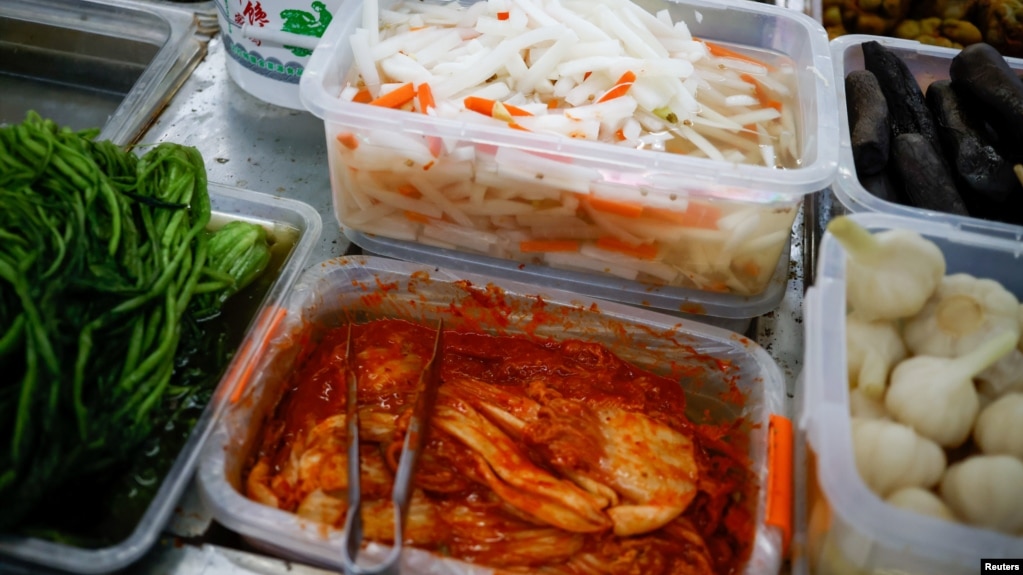
FILE - Korean style pickled cabbage, or Kimchi, and Chinese style pickled vegetables, or Pao Cai, are seen at a supermarket, in Beijing, China December 1, 2020. (REUTERS/Thomas Peter)
The coronavirus health crisis has interfered with almost every part of daily human life—including what we eat.
Nearly a year into social distancing, many people are enjoying foods long forgotten or once rejected for taste, feel or smell. Some have added healthful food to their diets to strengthen the body’s natural defenses.
Home cooking activity is up everywhere as a result of restrictions on restaurants and other food shops. People are increasingly exploring new food experiences in their own kitchens.
The joy of pears
Maeri Ferguson is a 31-year-old woman living in Brooklyn, New York. She got COVID-19 last year and recovered. But, the disease damaged her sense of taste and smell for months. Many of her favorite foods no longer satisfied her.
Ferguson can again sense sweetness, saltiness and spiciness, although many foods still seem to lack a strong taste — but not pears. The fruit was not part of her pre-COVID diet.
“I knew what a bad, unripe pear tasted like but not a good one,” she said. Thanks to a gift from a friend, she pushed herself to find a good example. It was one of the first foods she could truly taste again.
“I’m a full convert,” Ferguson said. “I’ll never forget biting into a juicy, red pear.”

Red wine poached pears with blue cheese and walnuts are seen in this Aug. 30, 2010 photo. (AP Photo/Larry Crowe)
Fermented foods
Fruits are simple pleasures. But fermented foods have also become popular. Fermented foods last a long time in the refrigerator which is a help if you go food shopping less often than before.
Anastasia Sharova, a chef in Stuttgart, Germany, runs Happybellyfish.com. The company is an online cooking school that works on healthy food. It added fermentation classes in late 2019. Then, the coronavirus crisis hit.
Suddenly, interest in making kimchi and sauerkraut, two kinds of fermented cabbage; and miso, fermented soybean, increased sharply. Earlier, Kombucha, a fermented tea, had helped popularize home fermented foods.
“Health became…number one for many last year,” Sharova said. She added that being at home caused many to make cooking discoveries. She said fermenting things is like a community activity done by families or in online classes.
Thirty-year-old Alicia Harper also has discovered fermented foods. She is a nutritionist in New York City. She did not like the strong tastes and smells of fermented foods at first.
“Since trying them again recently, my opinion has completely changed. I have now grown to love the taste and smell,” she said.
Anne Alderete of Los Angeles, California, is now enjoying natto. Made of fermented soybeans, natto is popular in Japan but considered too unusual by many people.
“I’ve smelled it many times since I’m half Japanese and lived in Tokyo after college for seven years,” the 47-year-old said. But she never liked to eat natto before COVID-19.
“I feel somewhat virtuous when I eat natto because the health benefits are many, but it’s also because it’s brought me closer to my roots,” Alderete said.

Hot dogs with sauerkraut. (AP Photo)
Concerns and comfort foods
Some experts think that changes in the way we eat also come from having more time to consider information about how food comes to our tables.
Ryan Andrews is a dietician who wrote a book on plant-based foods. Ryan is also an adviser for Precision Nutrition, which trains nutrition coaches. He said many people are learning painful truths about the food system.
Andrews said: “People have learned about the unsafe working conditions in meatpacking plants, the unfair wages of farm laborers.” He added that other problems include disease “related to diet,” cruelty to farm animals and the cost of industrialized agriculture.”
At the same time, the research company Semrush has studied Google searches related to changing food interests during the COVID-19 crisis. Their findings suggest comfort food and some unusual combinations are still on people’s minds.
The company found a 17 percent increase in searches for “peanuts and coke” in December when compared to December 2019. It found a 33 percent rise for “prosciutto and melon.” And, it found a 95 percent jump in searches for “bacon and jam.”
A service called WoodSpoon uses technology to connect people cooking at home with people willing to pay for a home-cooked meal. The company is based in New York. Its chief, Oren Saar spoke to the Associated Press. He suggested that before the health crisis, there was a strong interest in healthy, less processed foods. Afterwards, orders for breads, pasta and fatty meats increased.
“In challenging times like this, diners are looking for authentic, homemade food,” Saar said.
I’m Mario Ritter Jr.
And I'm Ashley Thompson.
Leanne Italie reported this story for the Associated Press. Mario Ritter Jr. adapted it for VOA Learning English. Caty Weaver was the editor.
_______________________________________________________________
Words in This Story
comfort –n. a state or feeling of not being worried, upset or unhappy, free of pain
fermented –adj. a chemical change in foods (and some industrial materials) that changes the nature of the food and often preserves it
jam –n. a sweet, sticky food made with fruit and sugar
challenging –adj. difficult
authentic –adj. real, genuine
Comprehension Quiz
What happened to Maeri Ferguson?